
MITSUBISHI Galant
Generations Timeline, Specs and Pictures
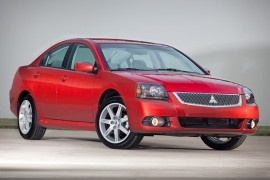
The facelifted Mitsubishi Galant made its appearance in 2008 at the Chicago Auto Show.
The new version brought a new styling and improved performance.
The Galant offered four trim levels and three performance levels, offering the buyers a wide variety to choose from.
The engines mounted on the Galant were either a 4-cylinder or one of the two V6s. The Galant ES trim level, as well as the Sport Edition were powered by a 2.4-liter powerplant that developed 160 hp, mated with a standard 4-speed automatic transmission. Semi-manual shifting was also a standard feature, available due to the Mitsubishi Sportronic system.
The standard equipment on the ES included air conditioning, power windows, rear-seats heated ducts, cruise control, ABS, EBD and alloy wheels, while the optional features included leather upholstery, a better audio system, a sport steering wheel with audio controls, automatic climate control, 17-inch alloy wheels, heated front seats and other trim specific features.
On the other hand, the Sport Edition had extra fog lamps, 18-inch alloy wheels, climate control air conditioning and auto-dimming rear-view mirror. Of course, the leather package was also optional for this trim level.
For the more passionate drivers, the V6 version had a more powerful engine that developed 230 hp and was mated to a 5-speed automatic transmission. It was not a big difference between the Sport Edition and the V6, however, with greater power should come more efficient brakes, which also happened for the Galant which was equipped with larger front brakes.
The top of the range was the Railart trim level, as the Galant was equipped with a 3.8-liter V6 engine that developed 258 hp. The brakes and suspension were also upgraded to sustain the powerful engine. The Railart had every feature offered by the Galant, with a single one being an optional: 7-inch touchscreen and a rearview camera.
The Galant was highly competitive in its range, mostly due to its numerous features and its quality price ratio.
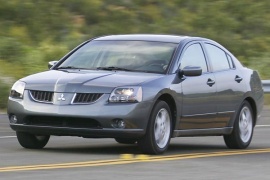
Remotely marketed in the US, parts of Central America, eastern Europe and the Middle East, the 2004 Galant saw a complete makeover, both visually and mechanically.
Passenger room was expanded, leading to an overall vehicle size and weight increase while some power units gained extra power output. The 2.4 L unit was upgraded from 140 to 160 hp while the previous generation introduced 3.0 L V6 was replaced by a larger 3.8 L capable of 235 hp compared to 190 hp. Available for US models only, the cars were fitted with 4-wheel disc brakes while rear suspension was stripped of the stabilizer bar.
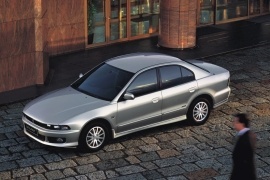
While the previous generation saw a suspension upgrade from struts to double wishbones in front and from beam axle to multi-link in the rear, the 97’ launched new Galant witnessed the return of the struts.
However, the rear suspension was further enhanced by adding a stabilizer bar, standard with all trims. Also known as the Legnum or Aspire, the freshly restyled car also came with a new range of engines. The small 1.6 L petrol unit was dropped while a new 3.0 L V6 carried for the loss. The new Galant was also slightly beefed up with a 0.5 in increase in length, height and width over previous generation models.

The eighth and last generation of the Galant VR-4 saw the launching lights in 1997, and it was a sports car dressed as a family sedan.
There were not too many family cars on the market that could get to 100 kph (62 mph) in less than six seconds and reach 240 kph (150 mph). Moreover, the Galant was packed with rally technologies and, thanks to its longer wheelbase, enough room for up to five adults.
With a styling heavily influenced by European sedans, the Galant showed a narrow, raked forward front area. Its wrapped-around bumper included an aerodynamic lower apron that sported the fog lights and another grille for the intercooler. Its three-box sedan shape featured curved lines and, in the back, a wing on the trunk confirmed the status of a sporty vehicle.
Inside, the carmaker installed a rather bland interior, with bucket seats at the front and a mix of grey and black dashboard. It didn’t even try to install white dials for the speedometer or tachometer. The car offered room for three adults in the rear, although the middle passengers had to sit on the transmission tunnel.
Under the hood, Mitsubishi installed a 2.5-liter, twin-turbo V-6 engine. It was paired with a standard five-speed manual or a five-speed automatic transmission from Porsche (Tiptronic), which offered the possibility to change gears sequentially by pulling or pushing the gear lever. The most important part of the car was the drivetrain, which featured an all-wheel-drive system with an active rear differential (Active Yaw Control) available as an option. Moreover, the carmaker installed an all-wheel-steering system. The disc brakes in all corners and standard ABS with
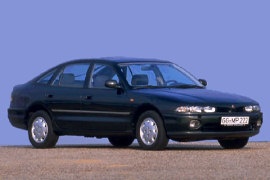
Having been available in both sedan and 5-door hatchback versions, the seventh generation Galant debuted as a sleek restyled vehicle.
Sharing its features with sedan the hatch was no different except its slightly smaller trunk and market coverage. While the sedan had been specifically tailored for the United States, the hatch was available in a few other regional markets, part in Central America, part in Europe. The most notable Hatch version is probably the GTi Dynamic-4, powered by a normally aspirated 2.5 L 6-cylinder petrol unit with a power output of 170 hp that pushed the car to top speed of 134 mph thanks to a 5-speed transmission and an all-wheel drive.
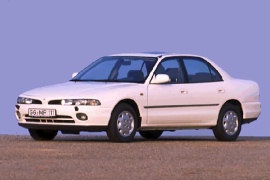
The ‘93 released Galant brought fresh chivalry-implants to Mitsubishi’s line-up.
Sporting a completely restyled body, the vehicle, also known as the Japanese-sold only Emeraude hard top and as the Eterna, came powered by a wide choice of engines comprised of three 4-cylinder units ranging in displacemnt from 1.8 L to 2.4 L and two V6 plants with capacities of 2.0 L and 2.5 L with the first having been available in a twin-turbocharged version as well. The 2.0 L petrol GTi had an output of 150 hp and could drive the car via a 5-speed manual transmission to a top speed of nearly 134 mph.
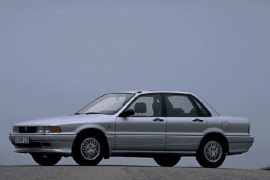
The sixth generation of the Mitsubishi Galant was a surprising upgrade over its predecessor and became a true sports sedan, especially after it received some treatment from AMG.
Mitsubishi built the 1988 Galant on the same platform as its predecessor but restyled it completely. It also introduced new powertrains and became the official rally-car for the Japanese carmaker starting with 1988 in the VR4 version that featured an all-wheel-drive system and a turbocharged engine.
On the outside, the carmaker adopted a two-headlights design instead of the four as its predecessor and added orange, corner-mounted turn signals. The body-colored plastic, wrapped-around bumper sported a lower apron designed more for look than to increase the front downforce. Mitsubishi designed an ascending beltline carried over from its predecessor, but the rounded body panels and shaved edges were new. The greenhouse featured a third slim glass area behind the rear doors, providing more natural light for the rear passengers.
Inside, the Japanese carmaker installed a flat dashboard with a raised area with a set of vents, a digital clock, and the instrument cluster’s sun visor. Since the carmaker struggled to get more market share, it provided more features fitted as standard than its competitors, including four power windows and an AC unit. At the bottom of the center stack, Mitsubishi installed a radio cassette player.
Under the hood, apart from the particular versions that featured all-wheel-drive and all-wheel steering, the rest of the range was quite common, with inline-four, naturally aspirated gasoline engines. A 1.8-liter turbo-diesel designed in-house was available for specific countries. The two-liter version received a special treatment and upgrade from AMG, which, in 1988, was not part of Mercedes-Benz. That made the Galant the only Japanese car ever tuned by the famous German tuner.























































